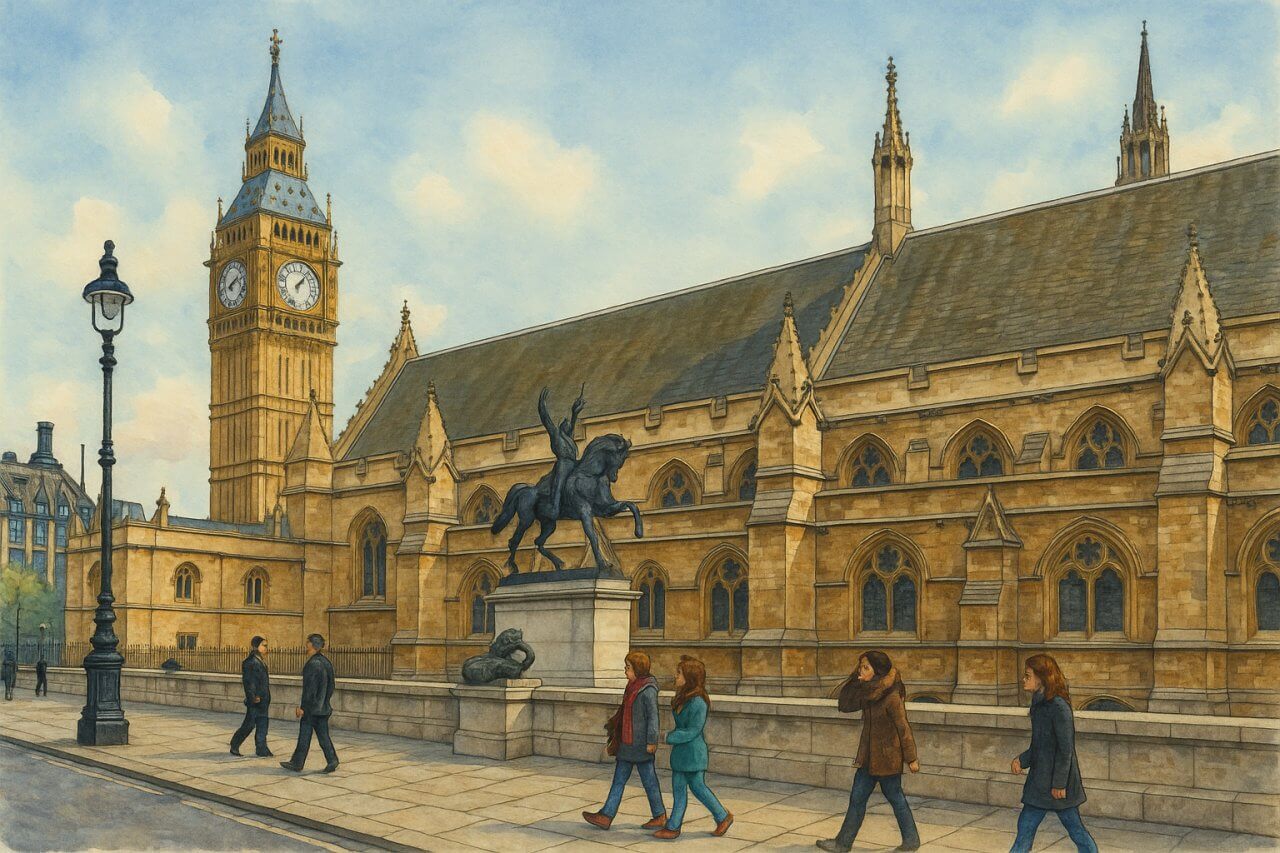
Palace of Westminster
The Iconic Heartbeat of British Democracy
With its Gothic spires rising beside the River Thames and the unmistakable chimes of Big Ben echoing across central London, the Palace of Westminster is far more than just a building — it’s the living symbol of British government, heritage, and identity.Location and Layout of the Palace
The Palace of Westminster is located in the City of Westminster on the north bank of the River Thames. It stands prominently between Westminster Bridge and Westminster Abbey, forming one of the most recognisable scenes in the world.The entire site stretches across approximately eight acres and is over 300 metres (roughly 1,000 feet) long. Its riverside façade is an unmissable part of the South Bank skyline, particularly when viewed from across the water on the London Eye or Jubilee Gardens.
This grand structure houses the two chambers of the UK Parliament:
- The House of Commons – the elected lower house.
- The House of Lords – the appointed upper house.
- Elizabeth Tower – famously known as Big Ben (though this name technically refers to the bell inside).
- Victoria Tower – located at the southwestern end, this tower stores important parliamentary records.
- Central Lobby – the symbolic heart of the palace, where members of the public can meet MPs.
A Seat of Power with Royal Beginnings
The Palace of Westminster has a rich and layered history. Its origins as a royal residence date back to the 11th century, when Edward the Confessor constructed the original royal palace near Westminster Abbey. The location became a preferred seat of English monarchs due to its proximity to London while still offering some seclusion from the bustle of the medieval city. However, the transition from palace to parliament began over time. After a devastating fire in 1295 damaged much of the structure, monarchs increasingly moved out, and the buildings started being used more frequently by Parliament, particularly for important state occasions. A defining moment came in 1834, when another great fire destroyed much of the existing buildings. The structure we see today was built in the aftermath, designed by architect Charles Barry with Gothic detailing by Augustus Pugin. Construction began in 1840 and took over 30 years to complete.The Palace of Westminster is  on the Map of the City of Westminster, London
on the Map of the City of Westminster, London
Why “Palace” of Westminster?
The name “Palace of Westminster” reflects its royal origin. It was once indeed a true royal palace and the primary residence of the Kings of England from the 11th century until the 16th century, when Henry VIII relocated the royal court to Whitehall Palace.Despite its current role as a parliamentary building, it retains its palace status — and is even technically a royal residence today. When the monarch attends the State Opening of Parliament, she or he is not considered a visitor but rather arriving at one of their official homes.
Nearest Underground Stations
The Palace of Westminster is easily accessible by public transport, especially the London Underground. The closest stations include:- Westminster Station – served by the Jubilee, District, and Circle lines. This is the most convenient stop, with exits placing you directly beside the palace and Westminster Bridge.
- St James’s Park Station – served by the District and Circle lines. A short walk through Parliament Street or Horse Guards Road will lead you to the palace from this quieter station.
- Embankment Station – on the north side of the river, also served by the District, Circle, Northern, and Bakerloo lines. Offers picturesque views of the Palace of Westminster across the Thames.

Painting of Palace of Westminster, London (View image in full size)
Fun Facts About the Palace
- Big Ben, often mistaken as the tower’s name, actually refers to the *Great Bell* inside the Elizabeth Tower.
- The building has over 1,100 rooms, 100 staircases, and 4.8 kilometres (3 miles) of corridors.
- Each monarch's throne speech is delivered in the *House of Lords*, with the monarch never entering the House of Commons chamber — a tradition dating back to the time of King Charles I.
- The building is cleaned manually by teams of abseiling professionals who scale the walls and towers with ropes.
Quick Facts
- Official Name: Palace of Westminster
- Location: City of Westminster, London, on the River Thames
- Main Function: Houses the UK Parliament (House of Commons and House of Lords)
- Notable Features: Elizabeth Tower (Big Ben), Victoria Tower, Central Lobby
- Original Use: Royal residence of English monarchs
- Architects: Charles Barry and Augustus Pugin
- Current Structure Completed: Mostly completed by 1870, post-1834 fire rebuild
- Nearest Tube Stations: Westminster (Jubilee, District, Circle), St James’s Park (District, Circle)
- UNESCO World Heritage Site: Yes, designated in 1987
- Visitor Tip: You can book guided tours of the Parliament when it's not in session
A Living Monument of Tradition and Power
The Palace of Westminster is not merely a heritage site or photo opportunity. It is the seat of living government, where debates shape the laws of the land and decisions ripple across the globe.Even for locals who pass it every day, the Gothic arches and golden spires never lose their impact. For tourists, it’s a must-see landmark — not only for its architectural majesty but for what it represents: centuries of history, tradition, and democracy in action.
Whether you're admiring its grandeur from Westminster Bridge, attending a public gallery session in the Commons, or catching the tower silhouette against a sunset sky, the Palace of Westminster offers a profound and uniquely British experience.